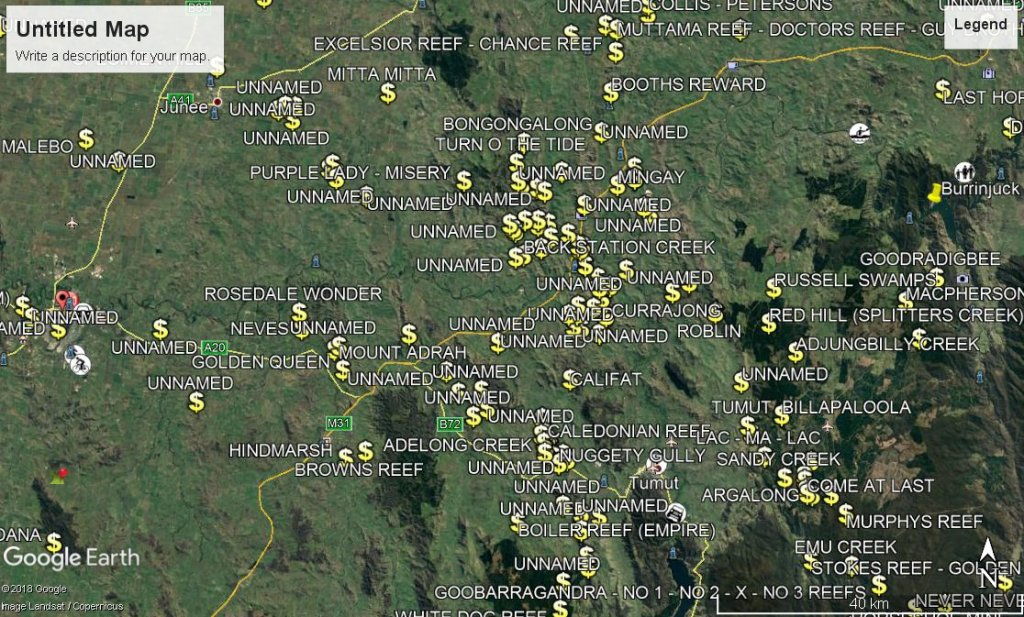Roel said:
Hi all. I live in Wagga and while not new to prospecting, I have yet to find my first nuggets. Which area, close to Wagga Wagga NSW would you recommend that may actually hold nuggets? I don't mind driving a few hours, but would hope to find a few nuggets if I spent a few days. Any help/advice appreciated.
Junee, Gundagai, Adelong, Holbrook and Temora would be your closest goldfields.
e,g,
GUNDAGAI Gold was identified by the geologist Rev. W. B. Clarke at Gundagai in 1842.[101] A gold rush hit the area in 1858 following further discoveries of gold and mining continued initially until 1875 and following a second gold rush in 1894, mines operated again until well into the 20th Century with some mining activity still occurring in 2007. The best known historical mines were the 'Robinson and Rice's Mine' (Long Tunnel Mine) a few miles to the south west of Gundagai and the 'Prince of Wales Mine' (where Herbert Hoover, the future President of the United States, was the mining engineer in about 1900[102]) a few miles to the immediate west of Gundagai. Both mines struck the orebody in quartz reefs along serpentine/diorite contact zones with finds of gold telluride (of bismuth origin) also found.[103]
'Nangus Island' in the middle of the Murrumbidgee River at Nangus is marked as one of the early goldfields and was previously named 'M'Arthur Island'. The island is adjacent to where the highly auriferous Adelong Creek enters the Murrumbidgee.[104]
The goldrush period in this area took place from 1861 to 1875 when a total of 134,456 ounces of gold was won. This was principally found in alluvial patches and leads at Big Ben, Brummys Hill, Stony Creek and Jackalass. The rocks in the neighbourhood comprise slates and conglomerates of Silurian age, associated with quartz porphyry, diorite, and serpentine. In many places the rocks exhibit features of strong crushing and shearing. It was found that the main gold-bearing ore bodies are of three main types being (a) Normal quartz veins occupying fissures in crushed sediments. (b) Lenses of slate replaced by chalcedonic quartz. (c) Deposits formed at or near the contact of serpentine and sedimentary rocks.
Gold was mined at Mt. Parnassus in 1894 near the town. Other reef mining nearby (known as the Emu line of reef) took place at the Morning Star, Mount Potter and Turn of the Tide mines. Other mines that operated in the district were the Bark Hut, Booths, Bongongolong, Bushmans, Clark, Eureka, Kimo, Long Tunnel, Princess Marina, Tarrabandra, Spring Flat and the Standard Mine. Ruins of the Prince of Wales gold mine can be found at Jones Creek near Reno, some 8 km NW of Gundagai.
HOLBROOK: Some small reef and alluvial gold mining took place. These included the Old Gibraltar and the Perseverance Mines were worked in slate country near Little Billabong.
JUNEE: The quartz reefs in granite known as the Junee Reefs are to the north of the town. These included Doctors, Dust Holes, Rockdale and Wallets reefs. At a location known as Spillers Gully, gold was won from a mica schist occurrence. To the southeast of Junee, both reef and deep alluvial ground was worked for gold at Eurongilly and Wantiool whilst considerable mining took place at Illabo and Old Junee.
WAGGA WAGGA: Very little is known about this area. However, records show that a few gold-bearing veins were found in the district (?) and at Pulletop.




